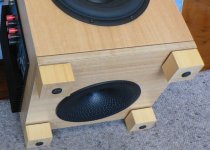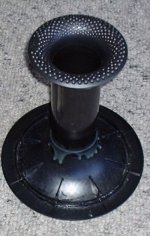I see all high end brands like KEF, Bowers & Wilkins, Kroma Audio, Wilson Audio, Dynaudio you name it use many huge (long throw) woofers, in pretty big cabinets with many going subsonic or close and have tiny and short ports in them but when I go design my bass enclosure in Unibox with two 8" long throw woofers in like 90 L with an F3 of 23 Hz in need such huge ports over half a meter long! How do brands do that? Using such numbers of huge (sub)woofers in relatively huge cabinets and only needing such tiny ports. Just look at the KEF Blade for example.
And by the way. In Unibox, what is ment with a flush port? The port being flush mounted at it's end but with just sharp edges, no rounded edges at all? I'm (if the port does indeed have to be as huge as they seem) using a slotted port but with rounded edges at the ends. Does that make it a flared port?
If you reduce the port diameter you also reduce the length needed to reach a certain tuning frequency. The disadvantage of a small diameter port is that the air velocity goes up so chuffing/turbulent noises occur at a lower volume. The advantage of using a shorter port is that pipe resonances in the port are pushed up to higher frequencies where they can be more easily attenuated by putting some stuffing material inside the box. Ultimately it's up to the designer to decide how big the port diameter should be based on how loudly the speakers need to play and how important it is to avoid turbulent port noises and port resonances.
The diameter of the port in the KEF blade certainly looks suboptimal for the amount of cone area but there may be more deciding factors governing port size than just acoustic performance. Firstly cost - a smaller port is cheaper to manufacture or they may already have a part that they can use from an existing design. The cost of redesigning their terminal plate with integral plastic port may be substantial. Aesthetics may also rule out using a larger port or multiple ports.
The diameter of the port in the KEF blade certainly looks suboptimal for the amount of cone area but there may be more deciding factors governing port size than just acoustic performance. Firstly cost - a smaller port is cheaper to manufacture or they may already have a part that they can use from an existing design. The cost of redesigning their terminal plate with integral plastic port may be substantial. Aesthetics may also rule out using a larger port or multiple ports.
Last edited:
Not really enough info to thoroughly critique the Blade, but with an apparently relatively high ~40 Hz tuning, dual flared 'L' shaped vents I imagine they're adequate for its claimed performance since at higher vent mach the tight bend will choke them somewhat [acoustic resistor].
Re 'flush' and 'flared', you assumed correctly. Note that when flaring a vent it must be longer for a given tuning: Port Flares
GM
Re 'flush' and 'flared', you assumed correctly. Note that when flaring a vent it must be longer for a given tuning: Port Flares
GM
Aesthetics may also rule out using a larger port or multiple ports.
It has dual ports and at this price level, my money's on all the trade-offs being aesthetics driven like the B&W Nautilus, [vintage] Altec Barcelona [most compromised I've experienced] and most higher priced consumer speakers I've been exposed to: https://3.bp.blogspot.com/-8eDy2r_p...YACEw/s1600/20161014_170222_29695787814_o.jpg
GM
An externally hosted image should be here but it was not working when we last tested it.
I think the Kef ports look sufficient. I'm sure they tested the speaker as a complete system and found the ports to not be the limiting factor.
Obviously the needs for high volume home theater subs is substantially different than woofers used in a 3-way for music.
I (against many others opinions) use 2- Dayton 12" subs for music with 3" ports and hear no I'll effects, most of the time the woofers are barely moving.
Obviously the needs for high volume home theater subs is substantially different than woofers used in a 3-way for music.
I (against many others opinions) use 2- Dayton 12" subs for music with 3" ports and hear no I'll effects, most of the time the woofers are barely moving.
They are people on this forum who say 4" ports are insufficient for the little tangband 6.5" subs. I have some of these subs and they are definitely suffering before the ports are chuffing significantly. I'm starting to suspect that people are blaming the ports when the drivers are actually hitting their limits.
Some manufacturers use some odd techniques to reduce chuffing such as B&W Flowport and Yamaha Twisted Flare Port.
In 2004 I used a small 65mm diameter B&W Flowport in a sub using the 830452 XLS and have never experienced chuffing on any movie LFE and is still in use today. The outside flange is around 200mm diameter.
I do have a little Yamaha 8" sub with the Twisted Flare but don't know if it works as only ever run at low SPLs.
In 2004 I used a small 65mm diameter B&W Flowport in a sub using the 830452 XLS and have never experienced chuffing on any movie LFE and is still in use today. The outside flange is around 200mm diameter.
I do have a little Yamaha 8" sub with the Twisted Flare but don't know if it works as only ever run at low SPLs.
Attachments
- Status
- This old topic is closed. If you want to reopen this topic, contact a moderator using the "Report Post" button.
- Home
- Loudspeakers
- Multi-Way
- How can ports be so small?


